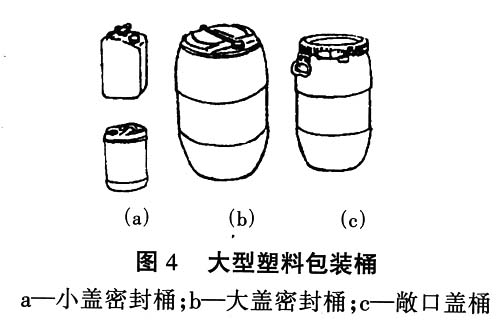4. Hollow plastic packaging container
Hollow plastic packaging containers generally use hollow blow molding. The common bottle-type, small-mouth bucket type, mainly used as a beverage, middle and low-grade cosmetics and liquid chemical products packaging.
5. Large plastic barrel
Large plastic drums range in volume from 5L to 250L, and molding methods often use rotary molding, injection molding, and extrusion molding. The structure has a small cover seal bucket, a large cover seal bucket and an open cover bucket. As shown in Figure 4.
6. Plastic packaging hose
The tube of the plastic packaging hose is generally extruded, while the neck of the tube is injection molded and then the two parts are welded. It is mainly used in the packaging of pastes, emulsions or liquids such as cosmetics, medicines, foods, watercolors, inks, and household chemical products.
7. Plastic bag packaging
Packaging bags made of plastic film and woven bags made of plastic are often used to package food, food, and chemical products.
Second, the plastic packaging container structure design factors to be considered
1. Plastic properties
Mechanical properties, including tensile, compression, bending, shear, impact strength, hardness, wear resistance, fatigue properties, creep load deformation, etc.; thermal properties, including molding temperature range, thermal expansion rate, heat distortion temperature, flammability, Embrittlement temperature, low temperature characteristics, etc.; electrical properties, including insulation, surface static electricity, etc.; chemical properties including chemical resistance to chemicals, moisture absorption, breathability, toxicity, chemical compatibility with the contents, etc.; optical properties, Including light transmittance, transparency, light resistance, radiation changes; other properties, including shrinkage, specific gravity, fluidity, colorability, printability and so on.
2. Formability of plastic containers
Molding conditions, including molding temperature, molding pressure, molding cycle; appearance quality, including micro-holes, cracks, burns, etc.; deformation, including post-deformation processing and corrective measures.
3. Mold structure and processing
Mold processing, including mold materials, mold cutting performance, mold processing methods; mold structure, including the parting surface, plated joint line, gate location, eject method.
4. Container use conditions
Container conditions must take into account the nature of the contents, the purpose of use, performance, and the state of use (temperature, humidity, load, etc.).
5. Economical
Economics include costs, values, promotional capabilities, consumer acceptance, and so on. (to be continued)
Hollow plastic packaging containers generally use hollow blow molding. The common bottle-type, small-mouth bucket type, mainly used as a beverage, middle and low-grade cosmetics and liquid chemical products packaging.
5. Large plastic barrel
Large plastic drums range in volume from 5L to 250L, and molding methods often use rotary molding, injection molding, and extrusion molding. The structure has a small cover seal bucket, a large cover seal bucket and an open cover bucket. As shown in Figure 4.

6. Plastic packaging hose
The tube of the plastic packaging hose is generally extruded, while the neck of the tube is injection molded and then the two parts are welded. It is mainly used in the packaging of pastes, emulsions or liquids such as cosmetics, medicines, foods, watercolors, inks, and household chemical products.
7. Plastic bag packaging
Packaging bags made of plastic film and woven bags made of plastic are often used to package food, food, and chemical products.
Second, the plastic packaging container structure design factors to be considered
1. Plastic properties
Mechanical properties, including tensile, compression, bending, shear, impact strength, hardness, wear resistance, fatigue properties, creep load deformation, etc.; thermal properties, including molding temperature range, thermal expansion rate, heat distortion temperature, flammability, Embrittlement temperature, low temperature characteristics, etc.; electrical properties, including insulation, surface static electricity, etc.; chemical properties including chemical resistance to chemicals, moisture absorption, breathability, toxicity, chemical compatibility with the contents, etc.; optical properties, Including light transmittance, transparency, light resistance, radiation changes; other properties, including shrinkage, specific gravity, fluidity, colorability, printability and so on.
2. Formability of plastic containers
Molding conditions, including molding temperature, molding pressure, molding cycle; appearance quality, including micro-holes, cracks, burns, etc.; deformation, including post-deformation processing and corrective measures.
3. Mold structure and processing
Mold processing, including mold materials, mold cutting performance, mold processing methods; mold structure, including the parting surface, plated joint line, gate location, eject method.
4. Container use conditions
Container conditions must take into account the nature of the contents, the purpose of use, performance, and the state of use (temperature, humidity, load, etc.).
5. Economical
Economics include costs, values, promotional capabilities, consumer acceptance, and so on. (to be continued)
How to apply and store sunscreen
Apply 15 minutes before you go outside. This allows the sunscreen (of SPF 15 or higher) to have enough time to provide the maximum benefit.
Use enough to cover your entire face and body (avoiding the eyes and mouth). An average-sized adult or child needs at least one ounce of sunscreen (about the amount it takes to fill a shot glass) to evenly cover the body from head to toe.
Sunscreen
DELIN HAIR COSMETICS , https://www.skinbeautymaskfactory.com